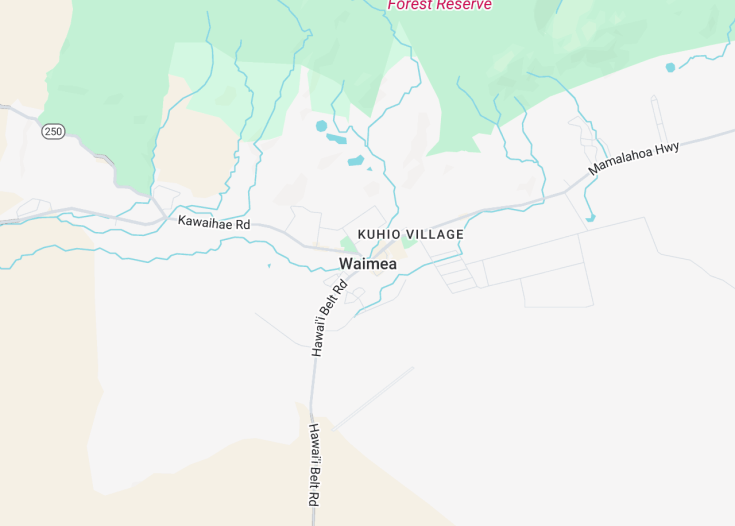Waimea, located in the heart of Hawaii’s Big Island, offers an enchanting blend of paniolo (Hawaiian cowboy) culture and beautiful natural scenery. Known for its rolling, green pastures and as a home to Parker Ranch, one of the largest ranches in the U.S., Waimea delights visitors with its rustic charm and cooler climate. This area also serves as a gateway to the majestic Kohala Coast and the awe-inspiring Waipio Valley, making it a perfect destination for those who appreciate outdoor adventures and authentic Hawaiian history and culture.
Ensure to visit the Waimea Homestead Farmers Market for fresh, local produce and genuine Hawaiian crafts—a delightful taste of local life and flavors.
Plan your visit during the annual Waimea Cherry Blossom Heritage Festival in February for a vibrant celebration of spring with cultural performances and traditional crafts.
Top things to do & see in Waimea
Select the following sights and activities to discover best tickets and tours available in Waimea.
Waimea: A Tropical Retreat
| Country | Hawaii (USA) |
| Time in Waimea | GMT-10 |
| Language spoken | English |
| Population | 9,212 (2020 data from the United States Census Bureau) |
| Currency | United States Dollar (USD $) |
| Airports |
|
Waimea in Hawaii, also known as Kamuela, is a delightful town that encapsulates the charm of the Hawaiian Islands. Located in the heart of the Big Island, Waimea serves as a bridge between the traditional and modern flavors of Hawaii. Known for its verdant rolling hills and robust ranching history, Waimea offers a unique glimpse into the ‘paniolo’ (Hawaiian cowboy) culture. The region is surrounded by majestic Mauna Kea to the north and the Kohala mountains to the northwest, providing breathtaking backdrops and fertile grounds ideal for agriculture.
Life in Waimea is quiet yet enriched with vibrant cultural expressions, evident in the numerous local festivals celebrated throughout the year, such as the Cherry Blossom Heritage Festival, which delight both residents and visitors. The town is also a hub for astronomical research, due to its proximity to the Mauna Kea Observatories, a world-class facility renowned for its groundbreaking discoveries.
The temperate climate in Waimea, characterized by crisp mornings and cool evenings, greatly differs from the tropical heat typically associated with Hawaiian coastal areas, making it a rare gem for those seeking a cooler Hawaiian experience. Schools in Waimea, like Parker School and Hawaii Preparatory Academy, are noted for their exceptional educational standards, drawing families seeking quality education within the serene panorama of Hawaii.
Where is Waimea?
Situated on the Big Island of Hawaii, Waimea rests at the base of Mauna Kea, facing the Kohala Mountains.
Distances:
| Route | Distance by car | Time by car |
|---|---|---|
| From Hilo to Waimea | 57 miles (91 km) | About 1 hour, 15 minutes |
| From Kona to Waimea | 37 miles (60 km) | About 45 minutes |
What is Waimea famous for?
Waimea is renowned for its rich paniolo (cowboy) heritage, stunning landscape with green pastures, and as a center for astronomical research due its proximity to Mauna Kea’s observatories.
History
Ancient Waimea: Pre-1778
The history of Waimea traces back to ancient times when it was inhabited by Native Hawaiian communities. Known for its fertile lands and strategic location, Waimea was a significant agricultural and spiritual hub. The area was famed for its taro fields, a staple crop, which thrived in the rich, volcanic soil. Rituals and ceremonies pivotal to Hawaiian culture were also regularly conducted here, establishing Waimea as a place of reverence and importance among the early inhabitants.
The Arrival of Captain Cook: 1778-1820
The modern history of Waimea dramatically shifted in 1778 with the arrival of British explorer Captain James Cook. This marked the first documented European contact with the Hawaiian Islands at Waimea Bay, on the island of Kauai. Cook’s arrival initiated significant changes in the socio-economic and political landscapes of Hawaii, ushering in increased European influence and subsequent challenges to the native populations and their way of life.
The Plantation Era: 1820-1959
Throughout the 19th century and into the 20th century, Waimea saw the establishment of several sugar plantations, which became the backbone of its economy. The influx of immigrant workers, primarily from Japan, the Philippines, China, and Portugal, transformed the cultural fabric of Waimea. These plantations influenced much of the town’s development, including the introduction of new technologies and the construction of the Kokee Road for sugarcane transportation.
Modern Waimea: 1960-Present
Post the plantation era, Waimea began to evolve from an agrarian society to a more diversified economy, with a growing emphasis on tourism and recreation. Today, Waimea is known for its beautiful landscapes, including Waimea Canyon and the Na Pali coast, making it a popular destination for tourists seeking adventure and scenic beauty. The community retains a strong connection to its historical roots and continues to celebrate its rich cultural heritage through various festivals and events.
Visit Waimea
What to see and do in Waimea, Hawaii (USA).
Waimea offers a diverse array of attractions and activities for visitors. The most famous is undoubtedly Waimea Canyon, often referred to as the “Grand Canyon of the Pacific.” This natural wonder offers stunning views and numerous hiking trails catering to all skill levels. The town is also a gateway to the Koke’e State Park, home to diverse flora and fauna and additional opportunities for hiking and natural exploration.
- Explore Waimea Canyon and Koke’e State Park
- Visit the Captain Cook Monument
- Take a tour of the historic Waimea Plantation Cottages
- Participate in a traditional luau to experience Hawaiian culture
Festivals and Events in Waimea
Waimea hosts several cultural and community events throughout the year. The Waimea Town Celebration is one of Kauai’s oldest and largest festivals, typically held in February. It features a variety of activities, including traditional Hawaiian music, hula performances, and a rodeo. The Waimea Lighted Christmas Parade in December brings festive cheer with beautifully illuminated floats making their way through town.
Best time to visit Waimea
The best time to visit Waimea is between September and November when the weather is pleasant, and tourist crowds are fewer. The spring months, from April to June, also offer comfortable temperatures and the chance to see the lush landscapes post-rainy season.
Is Waimea worth visiting?
Waimea is undoubtedly worth visiting for those intrigued by natural beauty, cultural history, and adventurous activities. Its landscape alone, marked by the majestic Waimea Canyon and lush Koke’e State Park, offers some of the most breathtaking views in Hawaii. Coupled with rich historical sites and vibrant cultural festivals, Waimea provides a unique glimpse into both the past and present of Hawaiian life, ensuring a memorable and enriching experience for all visitors.








